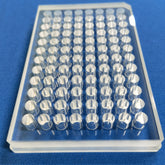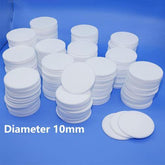Detailed instructions on how to use a quartz sample cell correctly
The quartz sample cell is fabricated from high-purity quartz glass, a material that exhibits superior light transmission, corrosion resistance, and mechanical strength. Its extensive utilization in analytical instruments, such as spectrophotometers and blood protein analyzers, is indicative of its efficacy in quantitative and qualitative analysis of substances. The utilization of quartz sample cells is imperative to ensure the accuracy and reproducibility of experimental results. The subsequent section provides a comprehensive description of the correct usage method.
1. Choose suitable product
Firstly, it is imperative to select a product that is compatible with the experimental requirements. The optical paths of quartz sample cells are known to vary, with lengths including 1mm, 2mm, 3mm, and so forth. It is imperative to select the most appropriate optical path in accordance with the specific experimental requirements. It is generally accepted that an increase in the length of the optical path results in an increase in the number of samples that can be accommodated. This, in turn, provides a larger optical path, which is more suited to the measurement of lower concentration solutions.

2. Cleaning and treatment
Prior to utilization, it is imperative to ensure that the product is in a pristine condition. The surface of the quartz sample cell should be gently wiped with a dust-free cloth or a special optical cleaning solution (e.g. ethanol or acetone) to remove any dirt or oil. Avoid using cleaners that contain particles, as this may scratch the surface.
3.Operation cautions
(1) Avoid direct contact
It is imperative to refrain from direct contact with the optical surface of the quartz sample cell, as this tends to leave fingerprints or other contaminants on the surface.

(2) Avoid violent vibration
Despite its hardness, quartz sample cell requires caution during handling to prevent damage from violent vibrations or collisions.
(3)Avoid optical surface damage
It is imperative to ensure that the optical surface remains unsoiled and free of scratches, as this has a direct impact on the precision and accuracy of the spectral analysis.
4. Sample loading
(1)Sample preparation
Prepare the sample solution to be measured. Ensure that it is transparent and free of suspended solids or bubbles, as these can cause interference with the spectral analysis results.

(2) Loading sample
Carefully load the sample solution into the quartz sample cell using a tip or pipette to ensure that no spillage or air is trapped in the sample cell, which can cause errors in the spectral measurement.
5. Spectral measurement
(1) Regulating spectral instrument
Select the appropriate wavelength and spectral range according to the experimental requirements. Ensure that both the light source and detector are stable and correctly calibrated.
(2) Recording data
When making spectral measurements, ensure that the experimental conditions, sample identification and measurement results are recorded. This will facilitate subsequent data analysis and interpretation of results.

6. Cleaning and storage
(1) Cleaning after measurement
Clean the quartz sample cell immediately after measurement to prevent sample solution residue from drying on the sample cell surface.
(2)Storage condition
To prevent the accumulation of dust and dirt, store dried sample cell in a dry, dust-free environment and protect the optical surface with a plastic bag or dust cover.
In order to ensure maximum performance and accuracy in spectral analysis, it is essential to adhere to the correct usage methods for the quartz sample cell. These steps not only improve the reproducibility of the experiment, but also extend the service life of the sample cell and reduce the cost and time of the experiment.






